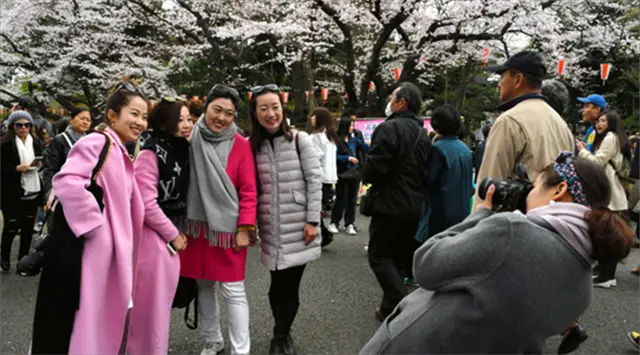Chinese tourists take photos in front of sakura trees in full bloom at Ueno Park in Tokyo's Taito Ward on April 1. (Kanako Miyajima)
Huge numbers of visitors arrived in Japan this year for the traditional sakura viewing season, and Japanese and Chinese tourism agencies scrambled to offer package tours that raised their enjoyment factor to the maximum.
Chinese netizens were quick to suggest the most “genuine” cherry blossom viewing spots in Japan that included Ueno Park and Shinjuku Gyoen National Garden in Tokyo, Kiyomizudera temple and Maruyama Park in Kyoto and Osaka Castle Park in Osaka.
At Ueno Park in Taito Ward, one of the capital’s most renowned sakura viewing spots, Chinese-speaking tourists are increasingly making their presence felt each year.
“My whole purpose of vising Japan this year is cherry blossom viewing,” said Zhao Jingfang, a 30-year-old company worker from Shanghai who visited the park with her four friends on April 1.
“I have never seen a place that is dominated by cherry blossom trees in full bloom like this and it is indeed very impressive,” said Zhao, adding it was the third time she had visited Japan.
The number of Chinese visitors to Japan totaled about 400,000 in April 2015, more than double that of a year earlier, according to the Japan National Tourism Organization.
Ctrip.com International, a major Chinese online tourism service company, projects that the number of Chinese tourists during this year’s cherry blossom season between March 15 and April 15 would further increase by 1.5 times from last year.
To take advantage of the craze among Chinese tourists, tourism agencies in China have actively promoted package tours to Japan that include visits to famed cherry blossom viewing spots from Tokyo to the southern Kyushu region.
A Ctrip spokesperson said that the company has arranged tours in Japan based on this year's sakura viewing forecasts.
“Chinese tourists now prefer overseas sightseeing tours that give insights to and experience the daily lives and indigenous culture of local residents,” said the Ctrip official. “Cherry blossom viewing in Japan certainly satisfies such needs.”
Japanese tourism companies, including JTB Global Marketing and Travel Inc., have also offered sakura viewing tours accompanied by Chinese-speaking guides.
Tao Yuan, the 39-year-old editor in chief at Witrip, which provides tourism information online and in magazines, said the Japanese culture of sakura viewing “differs greatly depending on the region, and Chinese tourists never tire of it.”
(This article was written by Kanako Miyajima in Tokyo and Kim Soonhi in Shanghai.)
(ASAHI)
 简体中文
简体中文

